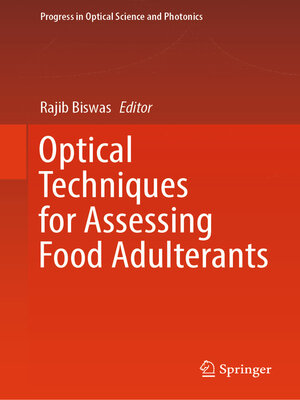Optical Techniques for Assessing Food Adulterants
ebook ∣ Progress in Optical Science and Photonics
By Rajib Biswas

Sign up to save your library
With an OverDrive account, you can save your favorite libraries for at-a-glance information about availability. Find out more about OverDrive accounts.
Find this title in Libby, the library reading app by OverDrive.



Search for a digital library with this title
Title found at these libraries:
| Library Name | Distance |
|---|---|
| Loading... |
This book explores the latest advancements in optical probe technology, their theoretical foundations, and practical applications in ensuring food safety. Food adulteration is a deceptive practice that misleads consumers for economic gain. It poses significant risks to public health and compromises the quality and nutritional value of food.
In recent years, optical probes have emerged as powerful tools for detecting food adulterants. Optical probes such as colorimetric probe, optical fiber probes, LSPR probes as well as SERS enabled probes are useful tools for detecting food adulteration in a fast and non-destructive way. Optical probes can measure various properties of food products, such as color, texture, moisture, composition, and authenticity, by using different types of light sources and detectors. Optical probes can also be integrated with other sensors, such as microfluidic devices, biosensors, or spectroscopic techniques, to enhance their sensitivity and specificity. Optical probes have several advantages over conventional methods of food analysis, such as portability, flexibility, low cost, and real-time measurement. Therefore, optical probes are a promising technology for the detection of food adulteration in various applications.







